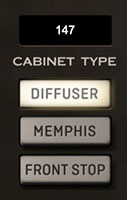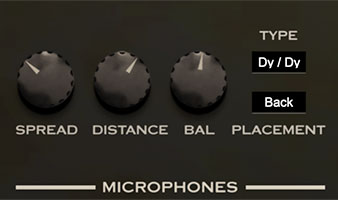
The CABINET page allows you to choose and from five different cabs or "direct" mode. It includes extensive editing capabilities, and it allows selections of three microphones and their placement.
CABINET TYPE

Use the popup menu at the top to select the desired cab type.

Direct- Turns off the cabinet simulation entirely, useful if you plan to send the organ signal through your own effects chain or amplifier. The output signal is taken AFTER the Drive circuit but before the Cabinet and as such is mono (because no stereo rotating cab).
122- Simulates the warmth and character of a vintage 122 cabinet.
147- Simulates a vintage 147 cabinet. Very similar to a 122 with a slightly different tone thanks to the unbalanced input circuitry.
Custom- Simulates a customized rotary cabinet with high output drivers and amplifier. While similar to the classic 122/147 sound, you’ll notice that it’s a little smoother and has slightly extended low and high end.
RA200- Simulates a rare guitar amplifier made by large Japanese company that also makes motocycles, and was made famous by David Gilmour (think "Shine On You Crazy Diamond"). It has three treble speakers rotating vertically in the top half of the cabinet and four 12” speakers in the bottom. It’s not the first thing you think of when you say rotary speaker, but it’s interesting and has a sound all it’s own.
4x12- Simulates a classic rock and roll guitar amp cab with four 12” speakers. (NOTE: no rotary effect with a 4x12 guitar cab. Duh!)
Diffuser- Classic rotary speakers have a diffuser at the mouth of the horn which smooths out the sound and makes it less directional. Turning off (removing) the diffuser makes it more directional along with harsher high end. Some 70s players removed the diffuser to cut through a wall of guitars better.
Front Stop- Forces the horn and bass rotor to face front when coming to a stop. Another feature that’s not possible with a standard rotary cabinet.
Memphis - Disconnects the bass rotor from spinning and forces it to face front.
HORN and BASS ROTOR

Some players like their rotary speaker speeds a little slower or faster. Here’s where you can make your adjustments to your liking.
Slow Speed - Adjusts the speed in slow or “chorale” mode.
Fast Speed - Adjusts the speed in fast or “tremolo” mode.
Acceleration - How fast the horn or bass rotor accelerate to fast mode from slow or stop.
Deceleration - How fast the horn or bass rotor decelerates from fast mode to slow or stop.
NOTE FOR RA200: The Bass Rotor section and Horn Slow are disabled (it has no bass rotors and its slow horn speed is fixed).
NOTE FOR DIRECT and 4x12: The Horn and Bass Rotor sections are disabled (for obvious reasons).
While every rotary speaker’s rotor speeds are slightly different because of belt wear and other factors, we’ve found that the most realistic speed settings are with the knobs near center position.
|
MINIMUM |
DEFAULT |
MAXIMUM |
|
|---|---|---|---|
|
Horn Slow |
0.25 Hz |
0.75 Hz |
1.25 Hz |
|
Horn Fast |
3.0 Hz |
6.75 Hz |
10.5 Hz |
|
Bass Slow |
0.25 Hz |
0.73 Hz |
1.21 Hz |
|
Bass Fast |
3.0 Hz |
6.4 Hz |
9.8 Hz |
|
Horn Acceleration |
0.25 secs |
1.2 secs |
2.15 secs |
|
Horn Deceleration |
0.25 secs |
1.5 secs |
2.75 secs |
|
Bass Acceleration |
1.0 secs |
6.0 secs |
11.0 secs |
|
Bass Deceleration |
1.0 secs |
4.5 secs |
8.0 secs |
When in RA-200 mode, the horn speed ranges are as follows:
|
MINIMUM |
DEFAULT |
MAXIMUM |
|
|---|---|---|---|
|
Horn Slow |
fixed at 0.85 Hz |
||
|
Horn Fast |
1.75 Hz |
4.625 Hz |
7.5 Hz |
MICROPHONES

These controls affect how we hear the rotary speaker by virtually moving the microphones. Spread and Distance both make a huge difference in the way we hear the rotary speaker so be sure to experiment with these.

Spread- Sets the spread of the horn mics in degrees. From 0 for a mono simulation to 45° for a standard micing technique, to 180° for a wide stereo spread. This adjustment only affects the horn. The bass rotor is miked from one microphone and is not affected by the Spread control. If you desire a mono output for any reason, set Spread to 0. Mic spread can also be set by dragging horizontally in the front quarter-view cab image.
Distance- Sets how far away the microphones are placed from the rotary cabinet. The closer they are, the more intense the throbbing is. Further away softens it. Mic distance can also be set by dragging vertically in the top view cab image.
Balance- Counterclockwise emphasizes the bass signal and clockwise increases the horn with straight up being an equal mix of both.
Placement- Controls whether the microphones are placed near the closed front or the open back of the rotary cabinet. The sound is a little mellower and woodier from the front, and a bit brighter from the back.
Type- You can choose the type of microphone for the horn and bass rotors separately to further refine the tone.
D/D (Dynamic on horn, Dynamic on bass) - A fairly standard live sound arrangement. Strong highs and punchy lows.
C/D (Condenser on horn, Dynamic on bass) - Less biting but extended highs.
D/C (Dynamic on horn, Condenser on bass)- Extended low end response.
C/C (Condenser on horn, Condenser on bass)- Extended low end and smoother, extended highs...more studio-like.
We can’t stress enough what a huge difference the Spread and Distance controls have on the sounds of the rotary speaker. For live, in-concert recordings, engineers typically place the mics very close to the rotary cabinet (in order to minimize bleed from other instruments), thus intensifying the strobing, particularly at fast speed. For studio recordings, mics are usually placed a little further back to smooth out the intensity.